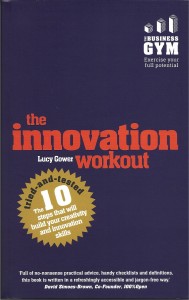The one sentence summary
You can improve your innovation skills by following a proven sequence.
WHAT THE BOOK SAYS 
- This is a primer for any individual or company wishing to embark on an innovation process.
- It guides the reader through 10 steps to enhance their innovation skills.
1. Pinpoint your purpose: think big to start with, and articulate the problem or unmet need in an inspiring way.
2. Know and understand your customers: innovations only work if people want them and can see how to use them.
3. Your market today and predicting the trends of tomorrow: being able to spot trends in sufficient time is pretty crucial.
4. Build your creative capacity: expand your experience, break routines and learn how to connect ideas together.
5. Creative superstardom and lots of ideas: have fun practising different techniques to help you and your colleagues to generate lots of ideas.
6. Don’t expect anyone else to like your idea: if it’s new or different (which it certainly should be), then you will have to spend time getting others to like it.
7. Filter and choose the best ideas: chance of success is one factor, as is the ability to say no to weaker ideas.
8. Prototype, fail fast and refine: creating working versions of the proposed innovation is vital to working out likelihood of success.
9. Pilot, adapt and invest: design, deliver and evaluate pilots without breaking the bank, often by borrowing resources from other interested parties.
10. Take your ideas to market: build a proper business case in conjunction with what you learn in the pilot phase.
- It then runs through a series of scenarios in which you might be enacting innovation: in a big organisation, on your own, with a team, with clients and customers, and so on.
WHAT’S GOOD ABOUT IT
- There are suggestions for how to innovate when no one else gets it, with no budget, by imitation, and when you feel like you are stuck.
- It takes you through how to develop an innovation framework, how to build an innovation network, and how to create the time to innovate.
- There is a self-assessment questionnaire at the beginning to weigh up your current innovation confidence and skills. This is repeated at the end to see how much progress you have made.
- The templates in the book are all available online at thebusinessgym.net – a helpful resource.
WHAT YOU HAVE TO WATCH
- This book will be very helpful to anyone entering the field for the first time, but there is little new for any long-term students of the genre.
